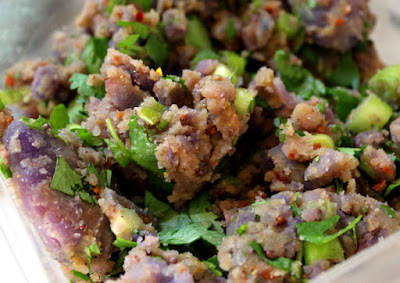A year or two ago, I watched a friend of mine toss some peppers in the oven to roast, so that she could use them throughout the week. Now, this friend is an excellent cook, a superbly efficient juggler of work and life and food and laughter, and generally full of top notch advice. In other words, one might think I would have taken notes. I should have gone straight home, acquired a large number of bell peppers, and commenced a happy and full life of weekly pepper roasting.
I did not.
What's wrong with me? Nobody knows. But belatedly, I have remedied my ways. I have become a Weekly Pepper Roaster. Or at least, an occasional weekly pepper roaster. Try it. Today. Or in a year. You'll see.
Make one for this dish, one for a fancy sandwich, one for a dreamy quesedilla, and one to pay yourself in snack taxes as you cook throughout the week.
Ingredients
Olive oil
1 large bell pepper
1/2 head cauliflower, chopped
1 bunch dino or green kale, diced
3 large cloves garlic, pressed
1 1/4 cups veggie or chicken broth
1 rounded cup whole wheat orzo
1 can butter beans, rinsed and drained
Slosh white wine or broth
Zest of about 3/4 of a Meyer lemon
1/2 cup Parmesan, grated with a microplane
Kosher salt and freshly ground black pepper
To roast the peppers:
Preheat the oven to 450°F. Take a roasting pan, brush just under where the peppers will go with olive oil, then lay the peppers on their side. Roast for 15 minutes, turn 1/4 turn, then roast another 10 minutes on each side (about 45 min total) until the peppers start to slightly deflate. Remove from the oven and set on a plate to cool. Pull out the core, cut them in half, peel, and de-seed. (Can be kept in the fridge in an air-tight container for at least a week...pour the leftover juices over them before refrigerating.)
Meanwhile:
While the peppers are roasting or just after they emerge, toss the chopped cauliflower in a drizzle of olive oil to coat, scatter on another baking pan, and cook in the oven until golden brown, stirring every 4 minutes or so (12-15 minutes total).
For the pepper you're using right now: Slice into strips lengthwise, then cut the strips in half crosswise.
Meanwhile, set a wide sautée pan over medium heat. When hot, add a generous glug of olive oil. Add the kale and toss to coat with the oil, then cover the pan and let cook for 4-5 minutes or so. Sprinkle with salt, stir, and then let cook for another 4-5 minutes. (It's fine if it browns, and it's fine if it doesn't. Don't stress. It will take care of itself.)
Bring the broth to a boil in a small pot for the orzo. When it reaches a boil, add the orzo, turn the heat down to low, and simmer 9 minutes or according to package directions.
Add the garlic and a little olive oil to the kale and sauté, stirring, for a couple minutes until the garlic softens. Add the butter beans and toss lightly. Stir in a glug of wine (or a slosh of broth, if you don't have white wine on hand). Cover for a couple minutes to let simmer. Uncover, stir in the lemon zest and the peppers, and replace the cover. Turn off the heat.
When the orzo is al dente, drain off any excess broth, then toss gently with the kale mixture. Stir in half the parmesan and a liberal dusting of black pepper. Serve warm, topped with the rest of the parmesan and the roasted cauliflower.
Serves 2.

















































